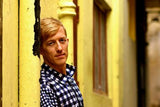Vande gurunam caranaravinde sandarsita svaatmasukhaavabodhe/
nihshreyase jaangalikaayamaane sansaara haalaahala mohashaantyai// (1)
Sadaashivoktaani saptaadalaksha Layaavadhaanaani vasanti loke/
Naadaanusandhana samadhimekam manyamahe maanya tamam layaanam// (2)
(2) There are 125,000 methods of laya (yogic dissolution) described by Lord Shiva in the world. It is my opinion that Naadanusandhaana (the pursuit of ‘inner sound’) into the deepest samaadhi is the best of all these layas.
- Yoga Taravali of Shankaracharya verses 1 (from opening Ashtanga chant) &2
I was raised around music. When I was a baby, my mother taught piano lessons and used to put my crib next to her piano. Her love of listening to and playing music infiltrated my life deeply. As a child, I sang in the church choir, and at 18, after playing classical guitar for a few years, I began my journey as a music major with an emphasis in classical guitar and voice. My real love, though, was writing and playing songs with friends. Perhaps it is best not to say too much about it, but there were definitely moments while playing and singing in different bands, or in the crescendo of chorale when I experienced a deep, inner bliss. Then, and now I wonder did these moments have to pass.
The more I practice Ashtanga vinyasa yoga the more I discover that sound and music are an important part of the yoga practice too, and can be an especially sweet type of pranayama, or life force alignment. Asanas themselves are perhaps a bit like different instruments. Each one a shape that produces waves of energy, different sounds, and a tuning in. These instruments not only carry the waves of energy (Prana) but are shaped by it as well. The better crafted the instrument, the better the breath that may pass through it and vice versa. Yoga practice includes not our just instrument bodies, but more importantly, the musical life force (prana) that may support these forms and the dynamics of the energy that passes & fills them. Here with a little luck these prana filled forms allow for symphonies with others to be created on and off the mat.
Yet, it seems I and most of us, often unintentionally escape and hide our breath away rather than clarify and fine-tune our instruments.
In high school, I can remember my voice teacher, Mrs. Adams, say, “If you are going to sing a wrong note, sing it loudly!” Just like when we are on the mat, Mrs. Adams required a presence of mind and authenticity that is obscured when we are afraid of being seen (or heard) as the one struggling. Yet, even when we are given permission to expose our mistakes, or to expose the cracks in our voices or bodies, this subtle hiding and attenuating is hard to get away from. Whatever tricks we employ to hide the breath, whether it is by taking breaks in the vinyasa, holding our breath a bit during the rough patches, or aiming to keep the breathing rhythmic without pause for over an hour, free, smooth breathing with sound is hard, real hard.
In my practice space in the quiet, subtle mornings, I find opportunities to begin again to cultivate the sine-wave like qualities of the inhale and exhale. There, my own instruments or postures are strung together and supported with the amplified breath and mind in solitude. In these still, quiet mornings, I daily aim for “free breathing with sound” and the symphony of surrender it promises. In these moments we may seek the subtle and cultivate listening to the innermost sound. The more we listen to the sounds of our breath, and dare to telescope into to the subtle cacophony of our own bodies, the more resilient we may become. And with the right intention, the subtle sweetness of our breath could be the best music we’ve never heard. So pull up a mat, sit on the edge of your seat, and listen close.
 John, Contemplative Science Center (CSC) Yoga programs manager at the University of Virginia, has been practicing Ashtanga yoga and studying spiritual practices his whole life. He has made 10 trips to India where he is a student of Shri Sharath Jois, Director of KPJAYI, Krisna Pattabhi Jois Ashtanga Yoga Institute, Mysore, India, and was graciously granted a level II authorization (2012) by his teacher. He was recently (2016) named one of the top 100 most influential yoga teachers in America.
John, Contemplative Science Center (CSC) Yoga programs manager at the University of Virginia, has been practicing Ashtanga yoga and studying spiritual practices his whole life. He has made 10 trips to India where he is a student of Shri Sharath Jois, Director of KPJAYI, Krisna Pattabhi Jois Ashtanga Yoga Institute, Mysore, India, and was graciously granted a level II authorization (2012) by his teacher. He was recently (2016) named one of the top 100 most influential yoga teachers in America.
Prior to joining the University of Virginia and the CSC team, John taught geology full time at a college in Asheville, Carolina for 7 years. He received a BS and MS in Geology with a focus on structure and tectonics. He has studied the fruits of various scientific and spiritual practices his entire life, and hopes to share what his gracious teachers have taught him with humility, warmth, and patience. To learn more about John you can visit his website at johnbultman.com

